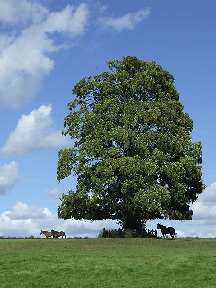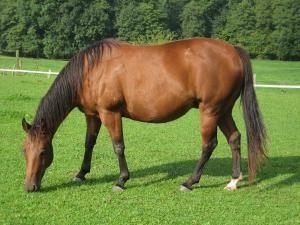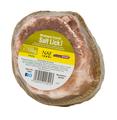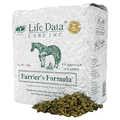What is Equine Atypical Myopathy?
Equine Atypical Myopathy (EAM) is a severe condition affecting the muscles of horses and donkeys. EAM has been reported in various parts of the world since the 20th century and has a high mortality rate of 70-80%. The problem presents sporadically, although it is most common in autumn grazing horses when pastures are bare, close to a river or stream and where sycamore trees (Acer pseudoplatanus) are present. Outbreaks also tend to occur following a bout of wet or windy weather.
Unlike other myopathies that purely target the locomotory muscles, Atypical Myopathy also affects postural, cardiac and respiratory muscles, thus making the condition much more likely to result in death.
EAM is unrelated to exercise or the overuse of muscles, as it was once believed. It can present in any horse, irrespective of breed, sex or age, although it is more common in young horses of 3-4 years. Only if the condition is diagnosed in its earliest stages can it be treated, yet even with intensive care, there are no guarantees the horse will make a full recovery.
While it used to be rare, the UK has recently seen an increase in the number of cases of diagnosed EAM. On the 16th October, the Royal Veterinary College announced it had seen five cases of Atypical Myopathy in just 72 hours. With this in mind and autumn now upon us, it is vital we make ourselves aware of the condition and its early presenting symptoms.
What causes Equine Atypical Myopathy?
Much like Equine Grass Sickness (EGS) for which we are still yet to identify a definitive cause, Atypical Myopathy used to be a mystery to veterinarians and horse owners until last year, when Belgian scientists were able to link the fatal condition to the sycamore tree.
 Today, it is believed that Hypoglycin A toxin, present in the seeds of sycamore trees (Box Elder trees in the US), is responsible for causing Atypical Myopathy. The condition occurs sporadically because Hypoglycin A isn’t present in all sycamore seeds or, in fact, all sycamore trees.
Today, it is believed that Hypoglycin A toxin, present in the seeds of sycamore trees (Box Elder trees in the US), is responsible for causing Atypical Myopathy. The condition occurs sporadically because Hypoglycin A isn’t present in all sycamore seeds or, in fact, all sycamore trees.
The levels of Hypoglycin A in seeds are highly variable so, while some sycamores will shed seeds that are practically free of the toxin, others will shed seeds containing lots of it. As there is just no knowing whether your trees are suspect or not, it is worth keeping your horses away from all sycamores as much as you can.
Even in fields with rich pasture, fence off sycamore trees from where your animals are grazing. Strong winds and rain can carry fallen seeds to neighbouring pastures so keep this in mind.
Hypoglycin A is accepted as the cause of EAM today, but further research still needs to be conducted to find out how disease occurrence varies seasonally and thus, how toxin levels must also change. Why is it that horses are more at risk during the months of spring and autumn? Probably because the seeds are shed and your horses have greater access to them on the ground.
If there is very little forage to be had by way of grass, your horse will content itself with rummaging through fallen leaves and seeds. If the grazing is poor then sycamore seeds are much more likely to get ingested. Also, if hay is left on the ground, your horse becomes more at risk. Keep forage in haynets attached to the fence and only leave bales out if you are sure there are no sycamores nearby.
What are the symptoms of Equine Atypical Myopathy?
Unfortunately for horses with Atypical Myopathy, clinical signs are severe, short-lived and almost always fatal. For owners whose horses have experienced EAM, seeing their rapid deterioration can be very distressing, especially since many people aren't familiar with the condition's presenting signs.
The earliest symptoms are often mistaken for colic as the affected horse may strain to urinate and/or have a distended bladder. The horse may also appear depressed and tucked up. Sudden onset stiffness and reluctance or inability to move will also be evident, leading eventually to recumbency and death. This usually happens within 12-72 hours. Another symptom to look out for is dark urine as this is a key indicator of Atypical Myopathy, presenting in roughly 95% of horses.
In order to distinguish EAM from similar diseases such as Equine Grass Sickness, Botulism, Acute Nutritional Myopathy and toxicosis caused by feed or plants, it is important to have your veterinarian examine your horse as soon as possible. All of these conditions are cause for emergency, so don't second guess your decision to contact your vet if your horse starts displaying symptoms.
If Atypical Myopathy is suspected and diagnosed early, intravenous fluids can be administered to reduce the clinical effects of the condition. IV fluids get to work by correcting electrolyte imbalances, restoring hydration, supporting renal function and ultimately restricting muscular destruction and associated complications. This autumn, be vigilant about where you graze your horse and if you suspect sycamore seed ingestion, contact your vet immediately.
Hopefully this article has been helpful and, should you have any further questions, feel free to contact me directly: [email protected]
Written by: Hannah


